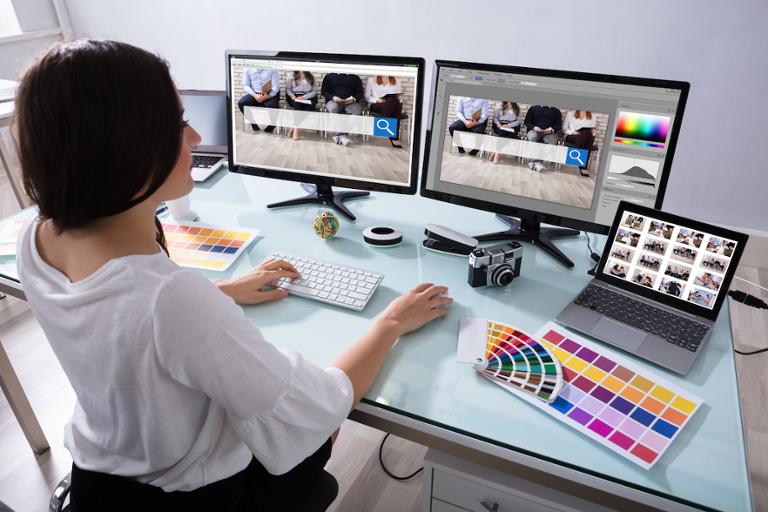Of all the disciplines in tech, graphic designer may be the most overlooked and underrated. Developers tend to think of designers as pixel-pushers who tinker in Figma all day long, but the job is far more than digital design—you must craft things that customers love at first glance, all while selling internal stakeholders on your vision. How high can a graphic designer salary go? Let’s take a look!
What does a graphic designer do?
Graphic designers are responsible for the visuals on a website, app, or other product. It’s a highly competitive field with a projected job growth of just 3 percent from 2021 to 2031. Successful graphic designers are not only skilled in ideating and creating designs; they also possess incredible “soft skills” such as communication and empathy, which allow them to efficiently determine project requirements, secure stakeholder buy-in, and communicate results to a client or organization.
Are graphic designers in demand?
According to Lightcast (formerly Emsi Burning Glass), which collects and analyzes millions of job postings from across the United States, there were some 55,206 open job postings for graphic designers over the past 12 months, indicating an average level of demand; the average time to fill a position was 43 days.
What’s the average graphic designer salary?
Lightcast estimates the median salary for graphic designers at $49,784, rising to $75,000 and above for those with more than eight years of experience. According to Dice’s most recent Tech Salary Report, that’s well below the average technologist salary of $111,348 (up 2.3 percent between 2021 and 2022). However, keep in mind that larger companies and/or those in larger tech hubs (such as New York City and San Francisco) may pay their graphic designers far more than the Lightcast median salary.
Specializing in a particular aspect of design can also unlock a much higher salary. For example, Dice’s Tech Salary Report pegs the average salary for UX/UI designers at $97,716 per year, down 3.5 percent between 2021 and 2022. Designers developing graphics and other assets for cutting-edge projects (such as virtual reality) may also leverage their unique skill-set into notably higher compensation.
What are the most valuable skills for a graphic designer?
In all those job postings for graphic designers analyzed by Lightcast, the top specialized skills included:
- Graphic design
- Adobe Photoshop
- Adobe Illustrator
- Adobe Acrobat
- Adobe Creative Suite
- Social media
- Typesetting
- Website design
Sensing a theme here? Extensive knowledge of Adobe products seems like a must. In addition, job postings tended to call out “soft skills” such as creativity, teamwork, communication, organizational skills, and good with deadlines as essential. Graphic designers lay the groundwork for what developers need to build, and they keep to keep an eye on changing design principles and trends; it’s also essential to give the customers what they want.
Is having a portfolio important for a graphic designer job?
In such a competitive market, it can be difficult to stand apart from other graphic designers. We spoke to several hiring managers and experts to find out what graphic designers can do to ensure they land interviews and get high-paying job offers.
Sam Orchard, Managing Director at Edge of the Web, tells Dice: “The role of a graphic designer is incredibly visual, so of course it’s super-important for applicants to have a strong portfolio of design work that they can share even prior to the interview stage.”
Alicia Mula Buitrago, Head of Content Product at Freepik Company, adds: “An eye-catching portfolio that proves an accurate application of design skills” work can be handy. Don’t be afraid to include relevant personal work.
“We value that designers don’t overlook developing personal projects to improve their portfolios,” Buitrago added. “These kinds of projects can best show their interests, styles, and skills. A great way for artists to learn is to experiment graphically, and client projects don't always let designers do that. But completing a portfolio with designs or illustrations of personal interest contributes a lot to develop a more defined style and skills.”
In short, a spectacular portfolio can give you added leverage when it comes to salary negotiations, especially if you’ve worked on complicated projects and/or delivered graphics that really helped a brand succeed.
Is teamwork important for graphic designers?
Ouriel Lemmel, CEO and founder of WinIt, tells Dice: “When I am hiring a graphic designer, I want to know that they have worked with a team and they have good communication skills. Collaboration is key, and since there will always be lots of input from various departments, I need to ensure that are able to deal with feedback in a collaborative way.
Orchard says: “One thing that I think is sometimes overlooked is communication skills, in particular the ability to interpret a brief and understand negative feedback. We work predominantly in digital design, so a lot of our designers’ work is on websites. And, for that, we need to carefully consider what the audience wants and create something that not only looks great but is functional and provides the best possible user experience too.”
The best graphic designers can think beyond their own tastes and needs, and understand how the designs will impact the target audience on an emotional and intellectual level. “That’s what I look out for when employing new graphic designers - an understanding of the functionality and strategy of their designs can make a candidate really stand out,” Orchard added.
Whether you’re negotiating your salary when onboarding at a new company, or trying to maximize your raise at your current employer, always make sure to emphasize your teamwork. Come prepared with stories of how you used your communication, teamwork, and empathy to help your team accomplish critical tasks and meet goals. Doing so will demonstrate how you’re a valuable employee… and well worth the extra cash.
What software platforms should graphic designers master?
Lemmel says: “When I am looking at a resume, I want to see that they have the ability to work with many software programs. This demonstrates that the candidate is proficient in multiple ways of working and will be able to accommodate more projects.”
Companies invest in certain design platforms and programs, and it’s often critical that candidates not only have experience but a high level of proficiency with those platforms. Typically, the job description for graphic designers will be transparent about which platforms are used at the company. Be sure to read through the job descriptions carefully before applying.
Buitrago adds: “As a product designer, a background in industrial design or engineering plus CAD software is desirable. On the other side, UX designers with knowledge in wireframing, prototyping, visual communication, and user testing skills would be in an advantageous position.” Knowing how to do the job in a specific platform will usually matter.
It’s important to note that knowing these platforms is critical to landing a job; many companies consider them “table stakes” when selecting a graphic designer. If a company engages in a highly specialized market (such as augmented or virtual reality), they may expect you to come with knowledge of the specialized tools necessary for that market; alternatively, they may also pay for training and education.
Will certifications impact a graphic designer salary?
Su Roberts, Company Director at Beliebis UK, says: “Companies like Adobe have their own certification, apart from the certification available from other graphic design companies. These certifications not only teach the skills, but also introduces the candidates to a practical environment by debuting them in one of their projects. This will help in standing out on a resume.”
Buitrago disagrees: “Graphic design is not a profession for which certifications are required,” she says, adding: “As design can be studied in many ways, it should be shown with a good portfolio.”
However, Buitrago continued, “We greatly appreciate that the designer shows an interest in learning and improving their skills. This shows that the designer has a passion for what they do. We would also value positively that the designer indicates that they have followed online courses or shows interest in participating in conferences or events.”
Via Emsi Burning Glass, here are a few of the graphic designer certifications that have popped up in job postings over the past few years:
- Certified in Adobe Photoshop
- Adobe Certified Expert (ACE)
- Adobe Illustrator Certification
- Graphic Design Certification
- Certified Graphic Designer
- Adobe Certified Associate (ACA)
- Adobe Captivate Certification
- Autodesk 3ds Max Certified
- Omg Certified Uml Professional
- Adobe Certified Instructor (ACI)
- Advertising Design Certification
- Adobe InDesign (Certified)
Certifications are a great way to display your skills. We advise leaning into certifications from the companies owning and operating the platform you’re getting certified in. If you’re looking for “generalized” certifications, keep in mind a prospective employer may want to verify the certification is legitimate; even if it’s simply a Udemy certificate of completion for a course, your next employer may quiz you about what you’ve learned and how you’d apply those skills.
Conclusion
When it comes to maximizing your graphic designer salary, it’s important to master a solid mix of technical and soft skills. For those applying to a new graphic designer job, a robust portfolio is crucial to securing a higher salary, as it’ll show you’re a masterful craftsperson.



